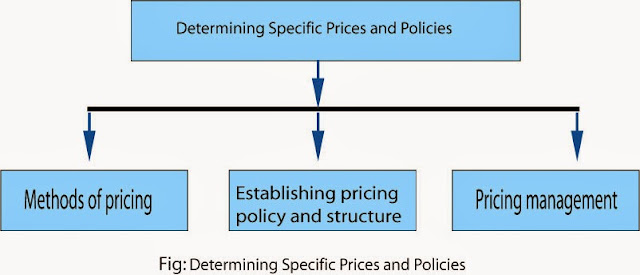The last step in pricing strategy is selecting specific prices and formulating policies to help manage the pricing strategy.Pricing methods are first examined,followed by a discussion of pricing policy.
a.Determining Specific Prices:
It is necessary to either assign a specific price to each product item or to provide a method for computing price for a particular buyer seller transaction.Many methods and techniques are available for calculating price.
1.Cost -based pricing:
Cost based pricing are two parts.a) Cost plus Pricing b) Break even pricing
a)Cost plus pricing:
Markup pricing is an item by adding a standard increase to the product's cost.
b) Break even Pricing:
Break even pricing is setting price to break even on the costs of making and marketing a product or setting price to make a target profit.
2.Demand oriented Pricing:
Demand oriented pricing is based on the level of demand for a product.The buyer is the frame of reference for these methods.One popular method is estimating the value of the buyer.The objective is to determine how much the buyer is willing to pay for the product based on its contribution to the buyer's needs or wants.Recall our earlier discussion of estimating value provided to the customer.
3.Competition based pricing:
Pricing decisions are always affected by competitors prices and their potential actions.In going rate pricing,the firm bases its price largely on competitor's prices.Sealed bid pricing forces the company to set prices based on what they think the competition will charge.
b.Establishing Pricing Policy and Structure:
1.Pricing Policy-
A pricing policy may include consideration of discounts,allowances,returns and other operating guidelines.The policy serves as the basis for implementing and managing the pricing strategy.The policy may be in written form although many companies operate without formal pricing policies.
2.Pricing Structure-
When more than one product item is involved,management must determine product mix and line pricing interrelationships in order to establish price structure.Pricing structure concerns how individual items in the line are priced in relation to one another.
c.Pricing Management:
Pricing strategy is an ongoing process rater than a once a year budgeting activity.Several principles of pricing management are outlined in importantly,pricing strategy is an interrelated process requiring central management direction and control.
1.Price Segmentation-
Price may be used to appeal to different market segments.For example,airline prices vary depending on the conditions of purchase.Different versions of the same basic product may be offered at different prices to reflect differences in materials and product features.
2.Value Chain Pricing-
The pricing strategies of sellers in the value chain should include consideration of the pricing needs of producers and facilitating firms.These decisions require analysis of cost and pricing at all value chain levels.If producer prices to intermediaries are too high,inadequate margins may discourage intermediaries from actively promoting the producer's brand.
3.Price Flexibility-
Will prices be firm,or will they be negotiated between buyer and seller?Perhaps most important,firms should make price flexibility a policy decision rather than a tactical response.Some companies price lists are very rigid while others have list prices that give no indication of actual selling prices.
4.Product life cycle pricing-
Some companies have policies to guide pricing decisions over the life cycle of the product.Depending on its stage in the product life cycle,the price of a particular product or an entire line may be based on market share,profitability,cash flow or other objectives.
<<<<<<<<<<---------->>>>>>>>>>















0 Commentaries:
Post a Comment